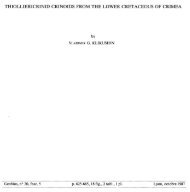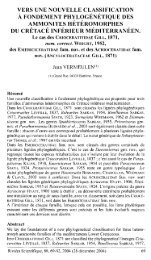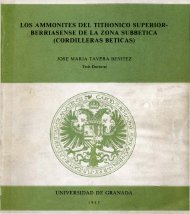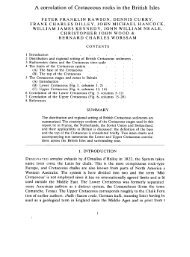New and poorly known Valanginian ammonites from South-West ...
New and poorly known Valanginian ammonites from South-West ...
New and poorly known Valanginian ammonites from South-West ...
You also want an ePaper? Increase the reach of your titles
YUMPU automatically turns print PDFs into web optimized ePapers that Google loves.
<strong>New</strong> <strong>and</strong> <strong>poorly</strong> <strong>known</strong> <strong>Valanginian</strong> <strong>ammonites</strong> <strong>from</strong> <strong>South</strong>-<strong>West</strong> Crimea 97the side. The most deep umbilical (U), <strong>and</strong> first umbilical(U 1 ) lobes are narrow, nearly symmetrical. The sutureline gets shallower to the umbilicus. The two followingoblique lobes are shallow.Distribution: As for the holotype.Genus Bodrakicerasgen. nov.Generic name: <strong>from</strong> the Bodrak River in the Bakhchisarayregion of <strong>South</strong>-<strong>West</strong> Crimea.Type: Hoplites Inostranzewi (KARAKASCH. 1889, p. 434,pi. I, figs. 1-3), Lower <strong>Valanginian</strong> of <strong>South</strong>-<strong>West</strong> Crimea.Diagnosis: Medium to large, discoidai, sub-involuteshells with moderate narrow umbilicus <strong>and</strong> abrupt umbilicalwall. Whorl section varies <strong>from</strong> hexagonal to hightrapezoidal. Cycles of ribbing arc separated usually bynarrow constrictions <strong>and</strong> consist of ribs having 3 rows oftubercles in the inner whorls. Each cycle contains onesingle rib, one bifurcate rib <strong>and</strong> one trifurcate rib in theyoung whorls (D40nim). Ribs stem<strong>from</strong> the umbilical edge at an umbilical tubercle (onmould, or spines in the shell), directed into the umbilicus<strong>and</strong> terminate by a ventral tubercle. The row of strongtubercles present at mid-whorl height marks Hie point ofvirgation. Ribbing becomes weaker to completely smoothin the adult. Some of the species (the type species at least)have a narrow ventral groove on the inner whorls.Suture line: (Figure 6). The ventral lobe (V) has adiversely divergent teeth; the umbilical lobe (U) is verylarge tripartite <strong>and</strong> asymmetric; the first umbilical lobe(U ) is narrower <strong>and</strong> shorter than the umbilical lobe.Saddles are bipartite, equal, or the external saddle (V/U) is shorter than the first lateral saddle (U/U 1 ). Theumbilical seam portion ofthe suture line descends steeplyinto the umbilicus with age.Composition: (see PL 2, Figs. 1-6).? Bodrakiceras gibbosum(VON KOENEN. 1902); B. constrictum sp. nov., B.discoideum (COLLIONON, 1962);? B, heteroptychum(PAVLOW, 1892); B. inostranzewi (KARAKASCH, 1889);B. quadristrangttlaium (SAYN, 1907).? B. sttbgibbosutn(WIEDMANN in KUTEK et ai. 1989): B. moutonianum(D'ORBIGNY, 1849-1850); r lB. neumavri (BEHRENDSEN,1892).Remarks: Hoplites Inostranzewi (KARAKASCH, 1889:p. 434, pi. I, figs. 1-3), the type of Bodrakiceras (SPUNo.218/1) was refigured as Hoplites Leopoldi in laterwork of KARAKASCH, 1907: p. 76, pi. XXVI, fig. 11),because of the similarity with Leopoldia in the rapidreduction of the sculpture. The type of Bodrakiceras issignificantly different <strong>from</strong> the type of Karakaschiceras(SPU No.218/2, Hoplites biassalensis, KARAKASCH 1889:p. 435, pi. I, fig. 4, 5 <strong>and</strong> refigured in KARAKASCH, 1907:p. 76, pi. XXVI, fig. 4) <strong>and</strong> it differs <strong>from</strong> Karakascliicerasin fine ornamentation, absence of well developedlateral <strong>and</strong> ventral tubercles, absence of deep constrictions<strong>and</strong> in having a very compressed involute shell. Inthe Crimean succession Bodrakiceras appears at the baseof the <strong>Valanginian</strong> succession, while Karakaschiceraswas recognised only <strong>from</strong> the uppermost Lower <strong>Valanginian</strong>(Kojas-Dzhilga region) <strong>and</strong> <strong>from</strong> the condensedhorizon on the Lower / Upper <strong>Valanginian</strong> boundary inKacha River sections. The holotype of Bodrakiceras inostranzewiis <strong>from</strong> Mangush Village (= Prokhladnoe Vil-Fig. 6 — The suture line of Bodrakiceras inostranzewi (KARAKASCH. 1 BS9>; MSU 95/3 under D-44 mm, H=15.0 mm; Lower<strong>Valanginian</strong>, Thurmanniceraspertransiens Zone (?) of Dlinnaya Mt., Prokhladnoe Village.
















